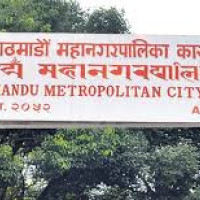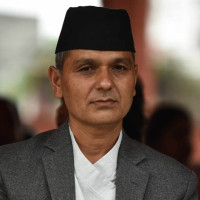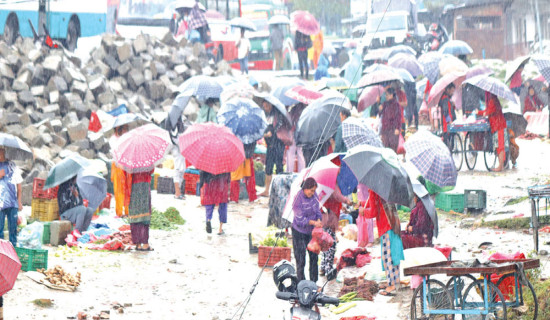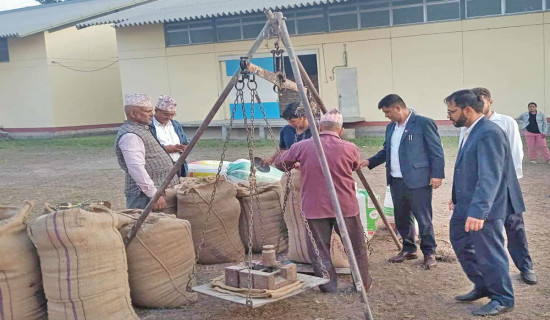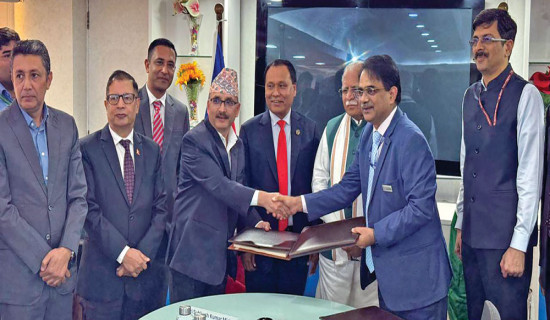- Sunday, 9 November 2025
Record-breaking forex reserves bolster Nepal’s external sector stability
Kathmandu, June 11: Nepal’s foreign exchange reserves have reached an all-time high, crossing the Rs. 2.5 trillion mark, driven largely by a surge in remittance inflows.
According to a current macroeconomic and financial situation report released by the Nepal Rastra Bank (NRB) on Tuesday, gross foreign exchange reserves rose to Rs. 2,512.95 billion in mid-May 2025—up by 23.1 per cent compared to the same period last year.
Nepal has added around Rs. 471 billion to its reserves in the first 10 months of the current fiscal year. The reserves stood at Rs. 2,041.10 billion in mid-July 2024.
Notably, Rs. 86.11 billion was added in a single month between mid-April and mid-May 2025, underscoring the growing strength of the country's external financial position.
In U.S. dollar terms, gross foreign exchange reserves climbed by 20.5 per cent, reaching USD 18.40 billion in mid-May 2025, up from USD 15.27 billion in mid-July 2024.
Growth of remittance inflows is one of the major to set a record high foreign currency reserves of the country. Four major sectors—export, foreign direct investment, foreign aid and tourism—are the main sources of foreign currency earnings. But, the volume of export has remained low and the FDI has slightly improved. In this context, remittance played a significant role to make the position of foreign currency reserves strong.
Breaking down the figures, NRB alone holds significant amount of Rs. 2,211.11 billion foreign currency reserves.
The reserves held by NRB increased by 19.6 per cent to Rs. 2,211.11 billion in mid-May 2025 from Rs. 1,848.55 billion in mid-July 2024.
Similarly, reserves held by banks and financial institutions (except NRB) increased by 56.8 per cent to Rs. 301.83 billion in mid-May 2025 from Rs. 192.55 billion in mid-July 2024. The share of Indian currency in total reserves stood at 21.2 per cent in mid-May 2025.
The significant increase in foreign exchange reserves is a positive sign for the country's economic stability and import management capacity.
Based on the imports of ten months of 2024/25, the foreign exchange reserves of the banking sector is sufficient to cover the prospective merchandise imports of 17.4 months, and merchandise and services imports of 14.6 months. The rising reserves now represent 44 per cent of the country's gross domestic product (GDP).
As per the revised estimates, the country's GDP stood at Rs. 5,709 billion for the last fiscal year 2023/24.
Similarly, the GDP of the country will be Rs. 6,107 billion in the current fiscal year 2024/25.
Likewise, forex reserves of the country reached much higher than annual budget. The government introduced a budget of Rs. 1,860.30 billion for the current fiscal year 2024/25. Likewise, the government has already presented a budget of Rs. 1,964.11 billion for the upcoming fiscal year 2025/26.
This significant improvement seen in forex reserves also indicate to have led to a widespread improvement in the external sector of the economy.
Remittance worth Rs. 1,356 billion received
According to the report, Nepal witnessed a robust increase in remittance inflows during the first ten months of the fiscal year 2024/25, with total remittances reaching Rs. 1,356.61 billion.
This marks a 13.2 per cent rise compared to the same period in the previous fiscal year, when remittance inflows had grown by 16.9 per cent.
Even though remittance inflows increased, the growth rate of inflows has decreased during the review period as compared to same period last fiscal year.
During mid-April to mid-May 2025 (Baishakh, 2082), remittance inflows stood at Rs. 165.30 billion. In the same period of previous year, such inflows amounted to Rs. 115.99 billion.
In the US dollar terms, remittance inflows increased by 10.5 per cent to 9.96 billion in the review period compared to an increase of 14.8 per cent in the same period of the previous year.
Net secondary income (net transfer) reached Rs. 1479.08 billion in the review period compared to Rs. 1301.75 billion in the same period of the previous year.
In the review period, the number of Nepali workers, both institutional and individual, taking first time approval for foreign employment stands at 405,610 and taking approval for renew entry stands at 280,314. In the previous year, such numbers were 373,307 and 236,398 respectively.
BOP surplus reaches Rs. 438.52 billion
Meanwhile, there has been further improvement in the current account and Balance of Payments (BOP) during the review period.Balance of Payments (BOP) remained at a surplus of Rs. 438.52 billion in the review period compared to a surplus of Rs. 392.64 billion in the same period of the previous year.
In the US dollar terms,
the BOP remained at a surplus
of 3.23 billion in the review period compared to a surplus of 2.95
billion in the same period of the previous year.
Similarly, the current account remained at a surplus of Rs. 255.93 billion in the review period
compared to a surplus of Rs. 193.31 billion in the same period of the previous year.
In the US dollar terms, the current account registered a surplus of 1.89 billion in the review period against a surplus of 1.45 billion in the same period last year.
In the review period, net capital transfer amounted to Rs. 8.48 billion. In the same period of the previous year, such transfer amounted to Rs. 5.26 billion.
Similarly, in the review period, Rs. 10.6 billion foreign direct investment (equity only) was received.
In the same period of the previous year, foreign direct investment inflow (equity only) amounted to Rs. 7.05 billion.





